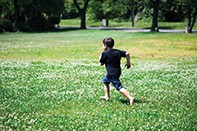A young boy experiencing drop attacks: what do you do next?
Case scenario
Jack, a 4-year-old boy, has recently been experiencing a few headaches and was brought in for a consultation by his mother. He was an alert and active child who was in no distress and, on examination, had no obvious neurological abnormality other than a mild and variable left strabismus (which had been present for years). His past history proved interesting; his mother said that he had been ‘born with the cord around his neck’, but that he did not require any prolonged intensive care and has subsequently met all his developmental milestones. From the age of 2 years, however, he has experienced unusual drop attacks. She said that when Jack was excited and running around, he would suddenly stop rigid and then fall backwards. By the time an adult had run over to pick him up, he had recovered and seemed otherwise normal. There were no postictal phenomena.
His mother initially thought Jack was acting, but after some time realised that he was not doing it voluntarily. Over the past couple of years Jack has experienced seven or eight of these episodes – all identical – the most recent of which had not been associated with his excitability. Jack had been referred six months previously to a neurologist and had undergone an EEG. His mother had been informed that he was not having seizures.
What could be happening to Jack?

